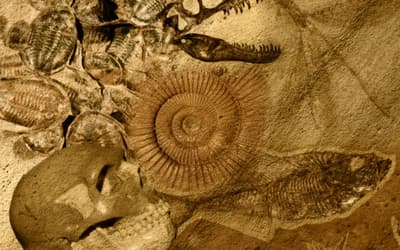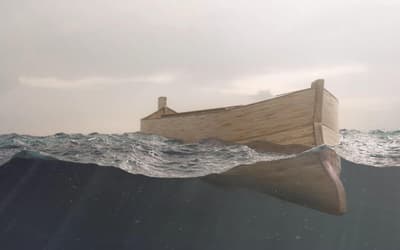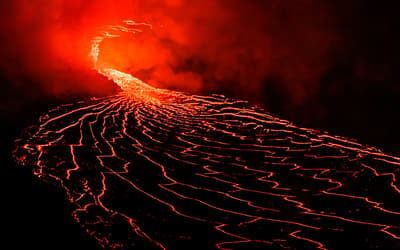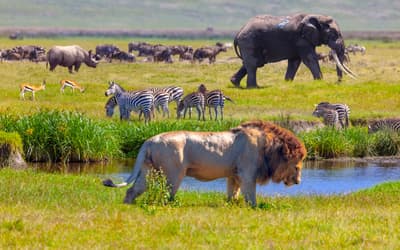The views expressed in this paper are those of the writer(s) and are not necessarily those of the ARJ Editor or Answers in Genesis.
Abstract
Microbial biogeography is a sub-discipline of microbial ecology dealing with microorganism distribution and abundance around the earth. The father of microbial biogeography, Martinus Beijerinck, is famous for saying “everything is everywhere, but the environment selects.” This statement permeates modern thought in microbial biogeography, but no secular explanation offers why this is true. If everything is everywhere as is claimed, then there ought to be some global distribution mechanism that explains why everything is everywhere in soils. Here, I hypothesize that the reason why everything is everywhere in soils is Noah’s Flood. Noah’s Flood offers the explanatory power lacking in secular reasoning to provide a rationale behind the statement “everything is everywhere, but the environment selects.” Evidence is presented that demonstrates Beijerinck was right to a certain extent—we do not find the microbial species everywhere, but we do find the microbial kind everywhere in soils. The microbial kind is defined here as the microorganism God created that is recognized at the family or genus level, which is helpful in understanding microbial biogeography. A model is offered for the microbial biogeography of soils in terms of Noah’s Flood. Then, an example is given in terms of the smell of rain as it comes from the soil bacteria Streptomyces. Afterwards, there is a brief discussion of the importance of worldviews when looking at evidence such as microbial biogeography. The biblical account of Noah’s Flood provides an update to modern microbial biogeography and modern creation apologetics with trillions of living things, contained in the soil, laid down by water, all over the earth.
Keywords: Noah’s Flood, microbial biogeography, microbial kind, Beijerinck, Streptomyces
Introduction
The primary evidence of a global catastrophe is Scripture. For the young earth creation researcher building a foundation for a creation model of biology, Scripture represents the Creator’s eyewitness account from which all physical evidence is interpreted. Genesis 7:11 commences the beginning of the floodwaters covering the surface of the planet until Genesis 7:19 where all the high hills of the earth were covered. The Flood lasted from “the six hundredth year of Noah’s life, in the second month, the seventeenth day of the month” (Genesis 7:11) until “the six hundredth and first year, in the first month, the first day of the month” (Genesis 8:13). During Noah’s Flood, every land-dwelling, air-breathing animal was killed if it was not on the ark. One neglected aspect of modern Flood discussions is that both the great fountains of the deep opened up as well as the windows of heaven (Genesis 7:11). While we understand that the great fountains of the deep were responsible for where most of the water came from, we must not forget that there was rain, also. As the fountains of the great deep opened alongside the windows of heaven, the floodwaters raised from the lowest levels to the highest levels. As the water progressively rose from lower elevations to higher elevations, animals were rapidly buried and some were fossilized. Scripture also indicates that all the mountains at the time of the Flood were covered with water up to 6.7 m (22 ft) (Genesis 7:19–20). Even the New Testament affirms that the entire world was destroyed with water (2 Peter 3:6). So water covered the entire earth for the span of approximately one year. During that time, the fossil record was deposited in the geologic record (Snelling 2008b). The fossil record includes several fascinating aspects that testify to the universality of the Flood in that we even find fossil ammonites at the tops of mountains all over the world (Snelling 2008a). Not only does the fossil record bear evidence of the global catastrophe, but so also do a variety of worldly culture traditions (White 2007). Truly, Scripture, the fossil record, and worldly cultures all testify to the fact that the Flood was a major catastrophe covering the entire surface of the globe. But are there additional lines of evidence of a global Flood?
The purpose of this paper is to examine the claims made within microbial biogeography to see how Noah’s Flood applies to it. In this paper, there will not be a treatment of all ecosystems, but more of a focus on soil ecosystems. To do this, the fossil record is surveyed as scientific evidence for a global Flood. Then, a brief survey of macroorganisms and microorganisms are offered to highlight apparent discrepancies in biogeography. From the discussion of microorganism biogeography, a definition of the microbial kind is proposed around the family or genus level. Having established the microbial kind, different dispersal mechanisms are evaluated for their plausibility in providing the global distribution of the microbial kind over land (which is discussed next). Then, the biblical case for Noah’s Flood becomes the primary mechanism in place for producing global biogeography of the microbial kind in soils. A model for the Flood as a mechanism of microbial biogeography is offered with a specific case study in the soil bacteria Streptomyces. Finally, evidence from microbial biogeography is briefly discussed in terms of competing worldviews.
The Fossil Record: Dead Evidence of a Global Flood
As water levels rose, each ecosystem was buried with life forms present within a given ecosystem.
Young earth creationists interpret the fossil record as preserved pre-Flood ecosystems and not snapshots of evolutionary time (Snelling 2008b). One creationist model posits floodwaters rapidly burying life forms in each ecosystem. As water levels rose, each ecosystem was buried with life forms present within a given ecosystem. For example, Tyrannosaurus rex is found in similar rock layers as Triceratops. This burial mechanism suggests one reason why humans are not found with dinosaurs in the fossil record (that is, they did not cohabit the same ecosystem). Dinosaur fossils are present on separate continents today because they were living on one landmass before the Flood called Rodinia, which then gave way to Pangaea during the peak of the Flood (and the fossils were formed), before the continents separated from one another (putting fossils on all continents). The fossil record bears witness to a global Flood because there are billions of dead things, buried in rock layers, laid down by water, all over the earth (Ham and Hodge 2014). The data suggest that fossils within the rock layers represent former ecosystems with the appearance of fully-formed organisms (Snelling 2008b). These observations have led to the creationist view of the origin of life like a forest or orchard where each tree represents a created kind (Wise 1991). While the fossil record is great static evidence for a worldwide Flood (Austin et al. 1994), there is an abundance of living evidence that also lends support to the biblical narrative.
A Survey of Macroorganismal Biogeography
Biogeography is the sub-discipline within ecology dealing with the distribution and dispersal mechanisms of living organisms on earth. The field is divided into two main areas: macroorganisms and microorganisms and these areas are discussed below. The most significant obstacle to understanding modern biogeography is Noah’s Flood. Macroorganismal biogeography is complex because all macroorganisms must have descended from the ark and dispersed across the planet. In doing so, the creationist bears the responsibility of describing a mechanism for how all macroorganisms arrived at their current location. The only remaining issue, then, is where macroorganisms lived before the Flood. The only record we have of where most macroorganisms lived before the Flood is trapped in the fossil record (to be discussed below).
In this post-Flood world, we observe macroorganisms dispersed in unique ecosystems. Dispersal of macroorganisms to unique ecosystems is a difficult topic for both the evolutionist and creationist alike and has been reviewed elsewhere (Statham 2010). Suffice it to say that the creationist interpretation of biogeography makes more sense out of coordinating where macroorganisms are found in the fossil record and on which continent we find macroorganisms today. One difficult issue surrounding the fact that there was a Flood still remains this idea of how did macroorganisms get to their present day locations. For example, how did the marsupials end up predominantly on Australia? The factors in place providing for movement of macroorganisms across the globe include transoceanic transport on vegetation mats, transport by man, migration and partial extinction, and speciation (Statham 2010; Wise 2002). These mechanisms are powerful for explaining modern day biogeography. What is key to realize about the macroorganism biogeography is that we have macroorganisms living in distinct habitats/ ecosystems even in a post-Flood world. We even have remarkable evidences of recolonization after modern day catastrophes like Krakatoa or Mount St. Helens that highlight the ability of macroorganisms to regain access to a decimated ecosystem as what happened after the Flood (O’Malley 2008; Thorton et al. 1988). Again, empirical mechanisms powerfully explain macroorganism biogeography from the Flood until now and are better explanations than their evolutionary counterparts.
What remains less clear about macroorganismal biogeography is how the pre-Flood world looked because we have little direct evidence from Scripture (that is, we only know that birds dwelt in the air and that fish dwelt in the sea, but nothing more specific). One intriguing idea is that the macroorganisms inhabited distinct ecosystems before the Flood for the same reasons that they inhabit distinct ecosystems after the Flood (Snelling 2008b). This argument is made from the observations that fossil strata represent the ecosystems that organisms lived in before the Flood—hence there is the idea that they lived in separate ecosystems. This idea about distinct ecosystems before the Flood makes sense both in light of the fossil record and in modern day observations. While we see distinct ecosystems filled with distinct macroorganisms today, this is not the case at the microorganism level.
A Survey of Microorganismal Biogeography
Microbial ecology is the study of microorganisms and their environment. Formally, microbial ecology includes many sub-disciplines such as biogeochemical cycling, symbioses, and microbial biogeography. Microbial biogeography is the study of microorganism presence and abundance on the earth’s surface. Perhaps the most influential person within microbial biogeography is Martinus Beijerinck, who did his work in the early 1900s (de Wit and Bouvier 2006). He is credited for coining the phrase “everything is everywhere, but the environment selects” or some variation thereof (Atlas and Bartha 1992). The issue, however, is that Beijerinck did not originally make that claim, even though he is famous for saying it (de Wit and Bouvier 2006; O’Malley 2008). The original claim came from Professor Lourens Gerhard Marinus Baas Becking and it was originally in Dutch (“alles is overall: maar het milieu selecteert”) (Baas Becking 1934).
The claim of Baas Becking and Beijerinck was that every microbial species was present everywhere on earth—they were not accounting for centers of origin such as the mammalian intestine; they were more emphasizing the idea of what is out in the environment. Notably, Beijerinck promoted this claim without access to modern technology (for example, airplane travel, DNA sequencing, computers). In researching this claim, no attempt is made to explain why everything is everywhere; it is simply assumed to be a true statement that everyone should be using. The only idea related to why everything is everywhere has a loose association with the idea of spontaneous generation (O’Malley 2008). It is striking that such a statement (that everything is everywhere) is unsubstantiated in terms of its scientific origin and, most importantly, lacks any explanation for why this is true. Neither Baas Becking nor Beijerinck explained why they thought their statement was true, other than there has been sufficient time for microbiota to be dispersed everywhere (O’Malley 2008). The second part of their claim is that the environment selects. The idea is that the environment selects from the ubiquitous microorganisms (at the species level) so that there is an abundance of certain types of microorganisms while others are less abundant. The current literature supports both of their claims with some qualifications (there is cosmopolitanism of species on land, but no other ecosystems), but there is no attempt to explain these phenomena (de Wit and Bouvier 2006). It is important to note that creation microbiologists also acknowledge the ubiquity of microorganisms, but there is also no mechanistic creationist explanation reported for these phenomena either (Francis 2009, 2010). Neither secular nor creationist explanations currently exist for why everything is everywhere.
Several modern approaches to answering this biogeographical question have involved collecting soil samples across four continents to demonstrate that various Pseudomonas species (that is, a diverse group of predominantly environmental bacteria that are widely found across soil and water) are present on all continents, but that they are not necessarily the same species (Cho and Tiedje 2000). That study found that “soil fluorescent Pseudomonas populations are endemic at genotype level[s],” which still means that the genus Pseudomonas can be found everywhere even though there is endemism at the genotype level. The method of their sampling to determine how Pseudomonas is everywhere was by traditional culture techniques from soil samples across several continents. However, they go on to describe “soil heterotrophic bacteria in undisturbed sites are not globally mixed.” Cho and Tiedje (2000) are saying that identical species cannot be found everywhere on earth, but that speciation is a strong force occurring in soil populations everywhere. It is interesting to note, however, that the Pseudomonads (at the genus level) are found everywhere.
Another study from the same group went looking for bacteria in soils capable of mineralizing 3-chlorobenzoate (Fulthorpe, Rhodes, and Tiedje 1998). These authors collected soil samples from six regions on five continents. After collecting their samples, they enriched for bacteria capable of breaking down 3-chlorobenzoate. A total of 48 different genotypes were identified and were argued to favor the concept of endemism. However, several issues are associated with a proper understanding of the study. First, there were no species identified, only the genotypes. Second, it was argued that there were unique sites across the samples collected, which still does not address the first point that we are likely dealing with species endemism. Third, these could all be of the same kind of bacteria (discussed below) without really acknowledging it. Fourth, their sample size was extremely small for making any claims about endemism. Finally, it was noticeable that there were bacteria capable of breaking down 3-chlorobenzoate in each of the sites sampled. So it appears that there are bacteria whose role it is to break down recalcitrant compounds present in the soils across several continents (that is, cosmopolitanism) and not located in just one place (that is, endemism).
Based on a review of the current literature, the idea of endemicity among prokaryotic samples abounds (Martiny et al. 2006). However, there are several issues surrounding the ideas of endemicity based on this review of the current literature. First, there are only a couple of studies that sampled across continents and those studies have already been discussed as to why they are actually cosmopolitan.
Second, the studies listed in the review did not focus exclusively on soil geographies, but also included marine, lakes, desert crusts, river plumes, salterns, groundwater, drinking water, fresh marsh, and a salt marsh. The issue with collecting samples from non-soil samples is that the issue of endemicity versus cosmopolitan nature of these ecosystems is not a fair comparison from the perspective of knowing whether everything is everywhere on land—waters can mix evenly or enter currents and have unequal mixing. It is my contention that there is going to be a significant difference in soil versus non-soil cosmopolitanism and that soils should be cosmopolitan whereas non-soils are not. Variation in soil ecosystems is not as significant as variation among non-soil ecosystems (for example, salt marshes). The third issue associated with this review is that it was overwhelmingly molecular and lacked traditional microbial identification of the species. Fourth, this review is slightly older and does not reflect the latest research (discussed below). Fifth, the researchers were focused in at the species level and not at the kind level (which is discussed below). Had they focused in on the kind level, it is possible that they would have come to a different conclusion. The topic of species is not nearly as significant as identification of the microbial kind at each of the locations sampled globally.
What Is a Microbial Kind?
From a biblical perspective, creationists do not suggest that God created the “species,” but that God created the “kinds”—this is no different at the microbial level. The major difference with understanding the microbial kind is that the biblical kind is easier to understand at the macroorganism level than it is at the microorganism level for a variety of reasons. Primarily, the fact that macroorganisms do not undergo horizontal gene transfer (to be discussed below) simplifies macroorganism classification. It is generally accepted that the biblical kind for macroorganisms is at the family or genus level—this is likely the case with microorganisms as well (Hodge and Purdom 2008). Even though it may be difficult to envision the concept of the microbial kind, I advocate the idea that this is possible with some help by the concept of the superfamily. The idea of the microbial kind being at the level of family or genus is reinforced by the secular idea of the superfamily as evidenced within Enterobacteriaceae with the concept of horizontal gene transfer and the pangenome (Karberg, Olsen, and Davis 2011). The idea of the superfamily for Enterobacteriaceae has even garnered support from the creationist literature as well (Gillen and Augusta 2018). There are some exceptions to this rule for the family or genus level as is the case with macroorganisms like birds. We cannot be dogmatic on whether the microbial kind is at either the family or the genus level for other reasons as well, including changes to phylogenetic trees, new information on genetic compatibility, the inability for asexual organisms to breed with one another, and horizontal gene transfer. More work certainly needs to be done in further developing this concept, but is not the point of this article. Given all these limitations for definitively calling a microbial kind, it seems reasonable that the microbial kind is somewhere around the family or genus level for the reasons outlined herein (that is, the rule does not always apply equally at the family level for everything). While microbial species might not be present everywhere, it is interesting to note that the microbial kind (for example, Pseudomonas) is.
From a biblical perspective, creationists do not suggest that God created the “species,” but that God created the “kinds”—this is no different at the microbial level.
On a separate note and related to the idea of microbial kind is the topic of horizontal gene transfer within microorganisms. To be clear, horizontal gene transfer is the mechanism whereby DNA is transferred between two cells that are not related to each other. Mechanisms of horizontal gene transfer include conjugation, transduction, and transformation. Secular evolutionary literature makes much of the concept of horizontal gene transfer within microorganisms as a powerful mechanism of speciation (Doolittle and Brunet 2016; Soucy, Huang, and Gogarten 2015). While horizontal gene transfer occurs relatively frequently at the microbial level, this does not impact the idea of the microbial kind. More importantly, the amount of horizontal gene transfer required for the evolutionary worldview requires movement of genes that are extremely unlikely to transfer between species. For example, it is highly unlikely that a bacteria will transfer the 16S rRNA gene from one cell to another because (1) it has never been observed happening before and (2) there is no selection pressure to take on a different cell’s 16S rRNA gene. Just because bacteria are capable of horizontal gene transfer does not mean that they always do horizontal gene transfer for every gene. Horizontal gene transfer is invoked so rampantly in the secular literature that it is undermining the secular tree of life and the last universal common ancestor. Either horizontal gene transfer is occurring as widespread as the evolutionist would have us believe or there is a limited amount of horizontal gene transfer happening that is observable. Most of the time, horizontal gene transfer is invoked as an explanation based off of identifying similar DNA sequences between two unrelated species and it is dubbed horizontal gene transfer for lack of a better explanation (a better explanation could include the idea of purposeful intent by a Designer). Indeed, the only significant source of empirical horizontal gene transfer deals with the issue of antibiotic resistance genes (conjugation), resistance to heavy metals (conjugation), and pathogenicity islands (transduction) (Gillen 2007). As a result, horizontal gene transfer is an unlikely source of variation at the kind level outside of these empirically-determined mechanisms. While horizontal gene transfer cannot be dismissed carte blanche, it likely does not happen in nature as widespread as the evolutionary worldview requires. Furthermore, the entire idea of horizontal gene transfer completely undermines the evolutionary tree of life and common descent (Jerlström 2000). The empirical sort of horizontal gene transfer only reinforces the idea of the microbial kind as the exchange of genes only happens within similar kinds.
Microbial Dispersal Abilities Across Land
If non-spore-forming bacteria (for example, Pseudomonas spp.) are present everywhere on Earth’s surface, how do current data inform us of their dispersal methods? Standard microbial ecology textbooks emphasize how microbes do not move long distances through the atmosphere (Atlas and Bartha 1992). These data pose several problems for worldwide dispersal mechanisms. The first problem for life in the atmosphere is that light radiation increases with elevation. Microbes experience more harmful UV rays entering the atmosphere when travelling long distances, which will likely kill them before they reach their final destination. The second problem for life in the atmosphere is that microbes rarely go past the troposphere (that is, the layer of air above the stratosphere). Those microbes that do reach the troposphere will likely experience low mixing of gases (which likely prevents microbial respiration from occurring), high ozone (which is antimicrobial), and the harmful UV rays that were previously mentioned and be eliminated. The data suggest that no autochthonous microbes originate or inhabit the higher elements of the lower atmosphere (Atlas and Bartha 1992). Microbiota sampled in the atmosphere are transient and are on their way to somewhere else. Thus, the atmosphere cannot have a constant supply of living microorganisms to seed earth’s surface as a center of origin. Finally, animals are not a significant source of transport for microorganisms on a global scale. No microbial ecologist suggests animals as a mechanism of transportation for microbes on a global scale. To have animals transporting microbes on a global scale to any appreciable extent would require animals with a global distribution, which simply do not exist.
Granted, there is a significant microbiome present in cloud droplets (Amato et al. 2017). Included in these droplets are bacteria such as Pseudomonas. However, a strong assumption is that all cloud droplets are cosmopolitan and that they are the primary vehicles for dispersal. There is no denying that some pseudomonads get transferred from one location to another via cloud droplet, but that is not a significant source for bringing pseudomonads to the earth’s surface. Nor is it significant for explaining the cosmopolitan nature of pseudomonads despite weather patterns. Pseudomonads are found all over the earth and not just where certain weather fronts traditionally collide. Plus, movement via clouds would only explain a small fraction of their cosmopolitan nature due to their low abundances in the clouds. Additionally, it would take an absurd amount of time (that is, eons) for a species to disseminate via clouds. For these reasons, there remains a need to explain the full cosmopolitan nature of pseudomonads by some mechanism other than rainfall. This goes without mentioning the difficulty that strains experience once they arrive in the atmosphere. There is significant doubt as to whether these cloud droplet microbes are autochthonous or allochthonous.
There is one study, however, that addresses a potential mechanism for airborne microbial communities (Barberán et al. 2014). The study demonstrates that there are certain microbial phyla capable of traveling significant distances through the air. These phyla observed were from the Central Pyrenees (NE Spain) over the time span of three years. The authors found that there were some bacteria present in the atmosphere as a function of airborne dust particles. However, not all bacteria were found to be uniform in their sampling, which means that everything is not being distributed by this airborne mechanism. If everything were everywhere, then it would be expected that the winds would also be cosmopolitan and they are not. Furthermore, they strongly suggested that this mechanism of transport was only regional and they only speculated that this could explain transcontinental transport.
Of all the organisms making it to the atmosphere, only those that form spores (for example, fungi and bacteria) are favored for survival and transmission because spores are resistant to the physical constraints of the atmosphere. It is, therefore, not surprising to find some spores in the atmosphere (Amato et al. 2017; Barberán et al. 2014). But of those atmospheric spores (for example, Pilobus spp.), they only travel 1–2 m, which is hardly sufficient for a global distribution mechanism in a short amount of time. On a separate note, there are some examples of spores that can travel hundreds of miles over a period of years as evidenced by the fungus responsible for causing Tobacco Blue Mold (LaMondia 2010). Additionally, other fungal spores have been detected across continents—though this was due to a catastrophe (Mims and Mims 2004). Barberán et al. (2014) reported that only some spores were present in the airborne samples they collected. With those exceptions mentioned among other spore-formers, the vast majority of microbes survive only very short distances (millimeters) in the air and relatively few of those can survive travelling long distances primarily because microbes lose viability due to desiccation, particularly in lower atmospheric layers and during the day (Atlas and Bartha 1992). Thus, it is highly unlikely for non-spore-formers to travel long distances and cover the globe (that is, Pseudomonads still lack a global mechanism of distribution from an empirical perspective). For what it is worth, there should be an emphasis on a relatively few surviving long distances and they typically are spore-formers—everything is not capable of making the long-distance travel globally. Others have reinforced the idea that “the mechanisms governing microbial distribution remain poorly understood” (Nemergut et al. 2011). Importantly, it must be pointed out that while there may be a weak explanation for spore-formers traveling through the atmosphere, there is no significant explanation for transportation of the non-spore-formers. The problem of non-spore-former distribution remains and needs an explanation for global distribution. For a brief summary of microbes capable of travelling relatively small-scale dispersal and colonization rates, see Horner-Devine et al. (2004).
In summary, microbes travel through the atmosphere for extremely limited distances (globally speaking) and mostly do not survive distribution through the atmosphere. The only organisms that can spread through the atmosphere to any significant extent include spore-formers, but Pseudomonas spp. do not produce spores and, therefore, have no mechanism to spread global distances. It should be emphasized that Pseudomonas is not the only non-spore-former present in soil that has a global biogeography—there are trillions of other bacteria just as ubiquitous. It stands to reason that there are other mechanisms for microbial dispersal like on animals, but these mechanisms are simply unfounded in the literature.
Lest one think that this issue of global distribution for Pseudomonas is a problem, other microbial kinds also exhibit cosmopolitanism across earth. Examples of other microbial kinds with global biogeography (beyond the realm of bacteria) include microbial kinds such as the rotifer kind, bacteriophage kind, fungi kind, and amoebae kind (each of these have kinds within each of these divisions/species) (Dagamac et al. 2017; Fontaneto et al. 2008; Ramirez-Camejo et al. 2012; Thurber 2009). These claims of the cosmopolitan nature of microbes rings especially true with protozoans (O’Malley 2008). While each of these microbial kinds has a unique distribution across the planet (that is, their microbial species is not found everywhere), the microbial kind (that is, the baramin that God created at the family or genus level) is equally found all over the entire planet (that is, cosmopolitan and the microbial kind is found everywhere). This is evident especially in the lithosphere with modern high-throughput approaches that sample myriad sites globally.
Microbial Global Cosmopolitanism in the Lithosphere
Several studies have sought to determine the cosmopolitan nature of soils globally. Some of these studies are broader in focus and narrower scope, and vice versa. It is important to note that these papers highlight the various sampling and sequencing methods for addressing the cosmopolitan nature of soils worldwide.
High resolution of the cosmopolitan nature of bacteria has been observed across the entire continents of North and South America as demonstrated by soil sampling, amplifying the 16S rRNA gene, and sequencing them using pyrosequencing (Lauber et al. 2009). Every major bacterial kind (for example, green non-sulfur bacteria, gram-positives, proteobacteria, cyanobacteria, flavobacteria, and Thermotoga) was identified from this analysis, except for some thermophiles that were probably present in very low abundance (that is, not enough sequence reads). Interestingly, Lauber et al. (2009) concluded that everything is not everywhere because they focused on the bacterial species as opposed to the bacterial kind. It is important to stress, though, that every bacterial kind (at the family/genus level) was isolated from each of the 88 sampling sites across two continents. It seems likely that the microbial kind found at each location underwent speciation within the given niches, giving rise to strong similarities between sites without being identical at the species level. And so it ends up being endemic at the species level, but cosmopolitan at the kind level.
A recent survey of the biogeography of France analyzed 2173 soil samples across the country (Karimi et al. 2018). While France is not a large country, it is noteworthy that they analyzed such a large sample size and that they did so by pyrosequencing. While they uncovered a great amount of diversity between the samples, their results reinforced the idea that “everything is everywhere, but the environment selects” (Karimi et al. 2018).
An even grander study performed recently analyzed 237 locations across six continents using next generation sequencing (Delgado-Baquerizo et al. 2018). The purpose of their study was to identify what the predominant microbes were in soils across the globe, not in particular to characterize each individual site. Their results were surprising because they found that just 2% of the taxa identified represented more than half of the sites sampled. To put it in other words, they said that, “most soil bacterial phylotypes are rare and relatively few are abundant, but many of these are found across a wide range of soils” (Delgado-Baquerizo et al. 2018). In other words, the authors are claiming that everything is everywhere and that the environment selects. Of note, though, there was no mention of Beijerinck or Baas Becking or any of the other review papers discussed here to make their point.
But the remaining question is a matter of how did everything get everywhere?
In summary of all these papers sampling myriad sites using next generation sequencing, it appears that everything (that is, every microbial kind) is indeed everywhere and that the environment selects (that is, individual species are found in different locations) for soil biogeographies, but the remaining question is a matter of how did everything get everywhere?
Everything Is Everywhere Because of Noah’s Flood
The evidence thus far is that Beijerinck was right in asserting that everything is everywhere, but the environment selects for soil ecosystems. The big problem for the naturalist is a matter of the mechanism for a global dissemination of microbes so they become cosmopolitan.
In searching the literature for microbial biogeography, no one offers a naturalistic explanation for how everything got everywhere on the globe. The secret recipe appears to be deep time. The closest naturalistic explanation for microbial biogeography deals with the limit of how far apart some bacterial species are (for example, Pseudomonas), which is a maximum of 200 m, and no explanation is offered for why the species are 200 m apart (Cho and Tiedje 2000). The fact that the species are 200 m apart does not address why the Pseudomonas kind is everywhere (well beyond the 200 m maximal spreading). Even though the Pseudomonas species may be 200 m apart, it does not matter ultimately because the Pseudomonas kind is found everywhere. Granted, if the Pseudomonas kind is moved along air currents from one region to another, it would take up to millions of years for there to be any kind of global distribution (Barberán et al. 2014). Again, this reinforces from a traditional culture approach that everything is everywhere, but the environment selects.
Wherever we do not find the kind everywhere, it must also be considered that the environment has selected. For example, we do not find every kind located in extreme environments like hot springs— those environments have selected against many of the microbial kinds (Valverde, Tuffin, and Cowan 2012). However, it is noteworthy that we find extreme thermophiles in places like Antarctica (Atlas and Bartha 1992). It seems that extreme environments may have selected against “mesophiles,” but that the moderate environments have not selected against extremophiles (O’Malley 2008). The reason that the 98% of the taxa not being present everywhere is probably because they were selected against in some time past (Delgado-Baquerizo et al. 2018). Again, the role of the environment since the Flood cannot be easily dismissed in terms of explaining minor differences to why everything is everywhere (as Baas Becking and Beijerinck have said).
The missing ingredient for the naturalist has been a global mechanism for dissemination of microbes. Noah’s Flood offers a mechanistic explanation for the cosmopolitan nature of microbes in soil. Using Noah’s Flood to disseminate microbes across the planet then allows for the environment to select for local disparities at the species level that are endemic (for example, Pseudomonas).
Microbial Biogeography and the Flood: A Model
Alternative to naturalism, the best explanation of microbial biogeography for how everything got everywhere is Noah’s Flood. Scripture plainly teaches that all the high hills were covered with water (Genesis 7:19). What likely occurred during the Flood was that the microbes on the earth’s surface were covered by floodwaters and then evenly mixed during the year the Flood prevailed. As the floodwaters receded, bacterial kinds suspended in the floodwaters were deposited equally across the earth so that everything became everywhere. It is ironic, too, that the scientific community is even discussing the biogeography of microbes in light of their rejection of Noah’s Flood. So everything is everywhere because of Noah’s Flood and not because of the apparent unmentioned explanation for why everything is everywhere: millions of years of naturalistic processes.
Species differences between sites are more likely a reflection of local environmental conditions than everything not being everywhere.
Local differences must have arisen since the Flood as a result of different environments selecting for specific microbial populations (for example, hot springs). Species differences between sites are more likely a reflection of local environmental conditions than everything not being everywhere. For example, many of the high-throughput approaches to measuring microbial biogeography simply do not have enough depth of coverage to find everything everywhere. The changes between sites are often at the species level, but not at the family or genus level. So it is still a true statement that everything is everywhere, but the environment selects. What has been lacking until now has been a reason for why everything is everywhere, but the environment selects. Perhaps it is appropriate to consider the full effect of Noah’s Flood on microbial biogeography with an example of a microbe that everyone can relate to: Streptomyces.
A Practical Case Study: Streptomyces and the Smell of Rain
A case in point is the Streptomyces bacteria that are globally distributed (Holt 1994). Streptomyces are spore-formers known for antibiotic production and one of the compounds responsible for the smell of rain: geosmin (the compound geosmin combines with the compound petrichor, which is not bacterial, to form the smell of rain). First, Streptomyces release geosmin into the air when it rains. As the water hits the ground, the geosmin becomes aerosolized. Next, air currents carry the geosmin and we smell it, not the rain, coming in the distance. Geosmin can be experienced everywhere on the planet and is but one example of the global occurrence of a bacterial taxon.
It is interesting to speculate whether everything was everywhere before the Flood because that could mean bacteria like Streptomyces might not have been everywhere for everyone to smell the geosmin they release, i.e., the smell of rain could have been local and not global. It is interesting to speculate how all humans alive before the Flood may not have smelled the rain coming because the Streptomyces were not globally distributed yet. That does not mean there was no rain before the Flood, just that the smell of rain could have been localized in one part of Rodinia and not located elsewhere—a microbial biogeography of separate ecosystems like the macroorganismal biogeographies before the Flood (Snelling 2008b). If everything was not everywhere before the Flood at both the macroorganism and microorganism levels (Snelling 2008b), then the people alive when the rain fell for the Flood may not have even smelled it coming (in terms of the rain portion of the Flood, even though there were the great fountains of the deep). Technically, we cannot know the microbial biogeography before the Flood for a fact, but it is interesting to speculate what it may have been. The Streptomyces biogeography before the Flood was likely significantly restricted as the macroorganisms were before the Flood, so there would have only been a small number of people that could have smelled rain coming. Streptomyces biogeography today is significantly different, and we can smell rain coming, so we would have a different perspective on the Flood than those antediluvians.
The Battle of Worldviews for Bacterial Biogeography
When confronted with the data from this paper, evolutionists will mock and look poorly on its conclusions. According to their worldview, there has been sufficient amount of time for bacteria to get everywhere on the planet due to the naturalistic forces described in this paper (withstanding the Flood) given bacteria’s supposedly ancient origins. Does that mean microbial biogeography cannot be used to support Noah’s Flood? The answer to the question stems from an understanding of worldviews and that this is not a battle over whose evidence is right, but a battle for the same evidence. Microbial biogeography supports Noah’s Flood; it does not reject it. Therefore, microbial biogeography ought to be the friend of the creationist and not the enemy. It is impossible to prove beyond any shadow of a doubt whether the evolutionary worldview is struck down because this is all a matter of faith, ultimately. It is ultimately a matter of faith in billions of years of regional travel or faith in one year of global travel. Microbial biogeography is now another piece of evidence in the debate between creation and evolution that should be part of the debate because of the strong explanatory power that it provides for the biblical worldview. Evolutionists will say anything to dismiss this data, but it is hard to ignore the evidence that is all around us.
Conclusion
The ubiquity of microbes on earth is living evidence that there was a global Flood.
In summary, the ubiquity of microbes on earth is living evidence that there was a global Flood. Either microbes have travelled short distances for extremely long amounts of time (which is highly unlikely due to the numerous problems associated with global distance transport) or they have travelled extremely long distances in short periods of time. It is ultimately a matter of faith as to which perspective is true. The presence of microbes everywhere has never been given a mechanistic explanation from a secular perspective and the best explanation given is in terms of Noah’s Flood. For every step we take, the microbial kind is everywhere and should cause us to pause and remember that there was a global Flood. In particular, every time before it rains can be a reminder that God judged the world with water because of the geosmin smell we experience anywhere on the globe. We can smell the evidence of a global Flood just before God sends a rainbow to remind us that He will never use water again to judge the earth (Genesis 9:11,13). Biblical creationists can have confidence in the biblical account because the bacterial kind is everywhere. So now we can say that there are trillions of living things, contained in soil layers, laid down by water, all over the earth.
Acknowledgments
I would like to thank my colleague Tom Hennigan for significant and fruitful discussion of this topic. I am also thankful for the feedback received from the anonymous reviewers.
References
Amato Pierre, Muriel Joly, Ludovic Besaury, Anne Oudart, Najwa Taib, Anne I. Moné, Laurent Deguillaume, Anne-Marie Delort, and Didier Debroas. 2017. “Active Microorganisms Thrive Among Extremely Diverse Communities in Cloud Water.” PLoS One 12, no. 8 (August): e0182869.
Atlas, Ronald M., and Richard Bartha. 1992. Microbial Ecology: Fundamentals and Applications. Redwood City, California: Benjamin/Cummings.
Austin, Steven A., John R. Baumgardner, D. Russell Humphreys, Andrew A. Snelling, Larry Vardiman, and Kurt P. Wise. 1994. “Catastrophic Plate Tectonics: A Global Flood Model of Earth History.” In Proceedings of the Third International Conference on Creationism, edited by R. E. Walsh, 609–621. Pittsburgh, Pennsylvania: Creation Science Fellowship.
Baas Becking, Lourens Gerhard Marinus. 1934. Geobiologie of Inleiding Tot de Milieukunde. The Hague, Netherlands: W. P. Van Stockum & Zoon.
Barberán, Albert, Jessica Henley, Noah Fierer, and Emilio O. Casamayor. 2014. “Structure, Inter-Annual Recurrence, and Global-Scale Connectivity of Airborne Microbial Communities.” Science of the Total Environment 487 (July): 187–195.
Cho, Jae-Chang, and James M. Tiedje. 2000. “Biogeography and Degree of Endemicity of Fluorescent Pseudomonas Strains in Soil.” Applied and Environmental Microbiology 66 (December): 5448–5456.
Dagamac, Nikki Heherson A., Carlos Rojas, Yuri K. Novozhilov, Gabriel H. Moreno, Rabea Schlueter, and Martin Schnittler. 2017. “Speciation in Progress? A Phylogeographic Study Among Populations of Hemitrichia serpula (Myxomycetes).” PLoS One 12, no. 4 (April): e0174825.
Delgado-Baquerizo, Manuel, Angela M. Oliverio, Tess E. Brewer, Alberto Benavent-González, David J. Eldridge, Richard D. Bardgett, Fernando T. Maestre, Brajesh K. Singh, and Noah Fierer. 2018. “A Global Atlas of the Dominant Bacteria Found in Soil.” Science 359, no. 6373 (January): 320–325.
de Wit, Rutger, and Thierry Bouvier. 2006. “‘Everything is everywhere, but, the environment selects’; What Did Baas Becking and Beijerinck Really Say?” Environmental Microbiology 8, no. 4 (March): 755–758.
Doolittle, W. Ford. and Tyler D. P. Brunet. 2016. “What Is the Tree of Life?” PLoS Genetics 12, no. 4 (April): e1005912.
Fontaneto, Diego, Timothy G. Barraclough, Kimberly Chen, Claudia Ricci, and Elizabeth A. Herniou. 2008. “Molecular Evidence for Broad-Scale Distributions in Bdelloid Rotifers: Everything Is Not Everywhere But Most Things Are Very Widespread.” Molecular Ecology 17, no. 13: 3136–3146.
Francis, Joe. 2009. “The Organosubstrate of Life: A Creationist Perspective of Microbes and Viruses.” Answers in Depth 4: 18–28.
Francis, Joe. 2010. “What About Bacteria?” In The New Answers Book, Vol. 3, edited by Ken Ham, 309–318. Green Forest, Arizona: Master Books.
Fulthorpe R. R., A. N. Rhodes, and J. M. Tiedje. 1998. “High Levels of Endemicity of 3-Chlorobenzoate-Degrading Soil Bacteria.” Applied and Environmental Microbiology 64 no. 5 (May): 1620–1627.
Gillen, Alan L. 2007. The Genesis of Germs. Green Forest, Arkansas: Master Books.
Gillen, Alan L., and Matthew Augusta. 2018. “The Coliform Kind: E. coli and Its ‘Cousins’: The Good, the Bad, and the Deadly.” Answers in Depth 13. https://answersingenesis. org/biology/microbiology/coliform-kind-e-coli-and-its-cousins/.
Ham, Ken, and Bodie Hodge. 2014. Inside the Nye Ham Debate: Revealing Truths From the Worldview Clash of the Century. Green Forest, Arkansas: Master Books.
Hodge, Bodie, and Georgia Purdom. 2008. “Zonkeys, Ligers, and Wolphins, Oh My!” Answers in Depth 3: 71–73. https://answersingenesis.org/hybrid-animals/zonkeys-ligers-and-wolphins-oh-my/.
Holt, J. G. et al. 1994. Bergey’s Manual of Determinative Bacteriology. 9th Edition. Baltimore, Maryland: Lippincott Williams & Wilkins.
Horner-Devine, M. Claire, Karen M. Carney, and Brendan J. M. Bohannan. 2004. “An Ecological Perspective on Bacterial Diodiversity.” Proceedings of the Royal Society B 271, no. 1535 (January): 113–122.
Jerlström, Pierre. 2000. “Is the Evolutionary Tree Turning into a Creationist Orchard?” Creation Ex Nihilo Technical Journal 14, no. 2 (August): 11–13.
Karberg, Katherine A., Gary J. Olsen, James J. Davis. 2011. “Similarity of Genes Horizontally Acquired by Escherichia coli and Salmonella enterica is Evidence of a Supraspecies Pangenome.” Proceedings of the National Academy of Science USA 108, no. 50 (December): 20154–20159.
Karimi, Battle, Sébastien Terrat, Samuel Dequiedt, Nicholas P. A. Saby, Walid Horrigue, Mélanie Lelièvre, Virginie Nowak et al. 2018. “Biogeography of Soil Bacteria and Archaea Across France.” Science Advances 4, no. 7 (July): eaat1808.
LaMondia, J. A. 2010. “January Temperatures Predict Tobacco Blue Mold Severity: Evidence for Local Source and Long-Distance Transport of Inoculum in Connecticut.” Plant Disease 94, no. 1 (January): 119–124.
Lauber Christian L., Micah Hamady, Rob Knight, and Noah Fierer. 2009. “Pyrosequencing-Based Assessment of Soil pH as a Predictor of Soil Bacterial Community Structure at the Continental Scale.” Applied and Environmental Microbiology 75, no. 15 (August): 5111–5120.
Martiny Jennifer B. H., Brendan J. M. Bohannan, James H. Brown, Robert K. Colwell, Jed A. Fuhrman, Jessica L. Green, M. Claire Horner-Devine et al. 2006. “Microbial Biogeography: Putting Microorganisms on the Map.” Nature Reviews Microbiology 4, no. 2 (February): 102–112.
Mims, Sarah A., and Forest M. Mims. 2004. “Fungal Spores are Transported Long Distances in Smoke from Biomass fires.” Atmospheric Environment 38, no. 5 (February): 651–655.
Nemergut Diana R., Elizabeth K. Costello, Micah Hamady, Catherine Lozupone, Lin Jiang, Steven K. Schmidt, Noah Fierer, Alan R. Townsend, Cory C. Cleveland, Lee Stanish, and Rob Knight. 2011. “Global Patterns in the Biogeography of Bacterial Taxa.” Environmental Microbiology 13, no. 1 (January): 135–144.
O’Malley Maureen A. 2008. “‘Everything is Everywhere: But the Environment Selects’: Ubiquitous Distribution and Ecological Determinism in Microbial Biogeography.” Studies in History and Philosophy of Biological and Biomedical Sciences 39, no. 3 (October): 314–325.
Ramírez-Camejo, Luis A., Anabella Zuluaga-Montero, María Lázaro-Escudero, Verónica Hernández-Kendall, and Paul Bayman. 2012. “Phylogeography of the Cosmopolitan Fungus Aspergillus flavus: Is Everything Everywhere?” Fungal Biology 116, no. 3 (March): 452–463.
Snelling, Andrew A. 2008a. “High & Dry Sea Creatures: Flood Evidence Number One.” Answers 3, no. 1 (January–March), 92–95.
Snelling, A. 2008b. “Doesn’t the Order of Fossils in the Rock Record Favor Long Ages?” In The New Answers Book, Vol. 2, edited by Ken Ham, 341–354. Green Forest, Arkansas: Master Books.
Soucy, Shannon M., Jinling Huang, and Johann Peter Gogarten. 2015. “Horizontal Gene Transfer: Building the Web of Life.” Nature Reviews Genetics 16, no. 8 (July): 472–482.
Statham, Dominic. 2010. “Biogeography.” Journal of Creation 24, no. 1 (April): 82–87.
Thornton I. W., R. A. Zann, P. A. Rawlinson, C. R. Tidemann, A. S. Adikerana, and A. H. Widjoya. 1988. “Colonization of the Krakatau Islands by Vertebrates: Equilibrium, Succession, and Possible Delayed extinction.” Proceedings of the National Academy of Sciences USA 85, no. 2 (January): 515–518.
Thurber, Rebecca Vega. 2009. “Current Insights into Phage Biodiversity and Biogeography.” Current Opinion in Microbiology 12, no. 5 (October): 582–587.
Valverde Angel, Marla Tuffin, and Don A. Cowan. 2012. “Biogeography of Bacterial Communities in Hot Springs: A Focus on the Actinobacteria.” Extremophiles 16, no. 4: 669–679.
White, Monty. 2007. “Flood Legends: The Significance of a World of Stories Based on Truth.” Answers 2, no. 2 (April–June), 18–20.
Wise, Kurt P. 1991. “Baraminology: A Young-Earth Creation Biosystematic Method.” In Proceedings of the Second International Conference on Creationism, edited by Robert E. Walsh and Christopher L. Brooks, Vol. 2, 345–358. Pittsburgh, Pennsylvania: Creation Science Fellowship.
Wise, Kurt P. 2002. Faith, Form, and Time: What the Bible Teaches and Science Confirms about Creation and the Age of the Universe. Nashville, Tennessee: Broadman & Holman Publishers.




















